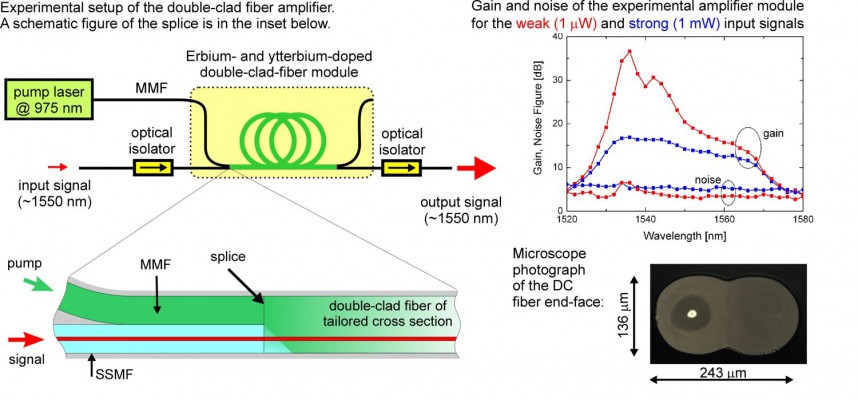Novel end-pumping method for double-clad fiber amplifiers and lasers
Year: 2006
Pavel Peterka, Ph.D.; Ivan Kašík, Ph.D.; Vlastimil Matějec, Ph.D.; Jiří Slánička
Fiber amplifiers are used in optical communications for compensation of signal losses in a transmission fiber. The invention of a cladding-pump technique enabled significant increase of the output powers of both fiber amplifiers and lasers. In these devices pump light of a high-power, but low-brightness, laser diode enters the large area of the inner cladding of a double-clad (DC) fiber and is gradually absorbed by rare-earth ions incorporated into a thin core of the DC fiber. The signal guided in the core is amplified via stimulated emission of the excited rare-earth ions. DC fibers are remarkably efficient at converting the output of high-power, low-brightness diode lasers into high-power, high-brightness beams. DC fiber lasers are replacing conventional solid-state lasers in many medium- and high-power applications.
We have proposed a novel pumping scheme for DC-fibers and demonstrated its application in a fiber laser [1, 2] and amplifier [3]. The pumping scheme is based on a unique patented design [4] where the pump and signal fibers are spliced directly to a DC fiber with a specifically tailored cross-section. This DC fiber also provides optimum absorption of the pump along the fiber. Moreover, the shape of the DC fiber resembles the cross sections of the pump and signal fibers as much as possible to facilitate their splicing.
The developed fiber amplifier module does not require any bulk or intermediate fiber coupling elements as it does most other clad-pumped devices. The splicing of the pump and signal fibers to the DC fiber can be done using commercial fusion splicer in an automated process with low losses for both the pump and the signal. Therefore we anticipate that the presented DC fiber module can find applications in cost-effective high-power fiber devices.
- P. Peterka, V. Kubeček, P. Dvořáček, I. Kašík and V. Matějec, „Experimental demonstration of novel end-pumping method for double-clad fiber devices“, Opt. Lett., 31, 3240-3242 (2006).
- „End-pumping scheme improves fiber-based devices“, Laser Focus World, December 2006;
- „End-pumping fiber amplifiers made easy“, bude publikováno ve Photonics Spectra.
- P. Peterka, I. Kašík, V. Matějec, M. Karásek, J. Kaňka, P. Honzátko, V. Kubeček, „Amplifier Performance of Double-Clad Er/Yb-Doped Fiber with Cross-Section Tailored for Direct Splicing to the Pump and Signal Fibers“, přijato k prezentaci, Optical Fiber Communication conf. OFC'07, Anaheim, USA, 2007.
- P. Peterka, V. Matějec and I. Kašík, „Method and device for coupling the signal and pump into double-clad optical fiber for fiber amplifiers and lasers“, patentová přihláška č. PV 2005-227, 12. dubna 2005.


